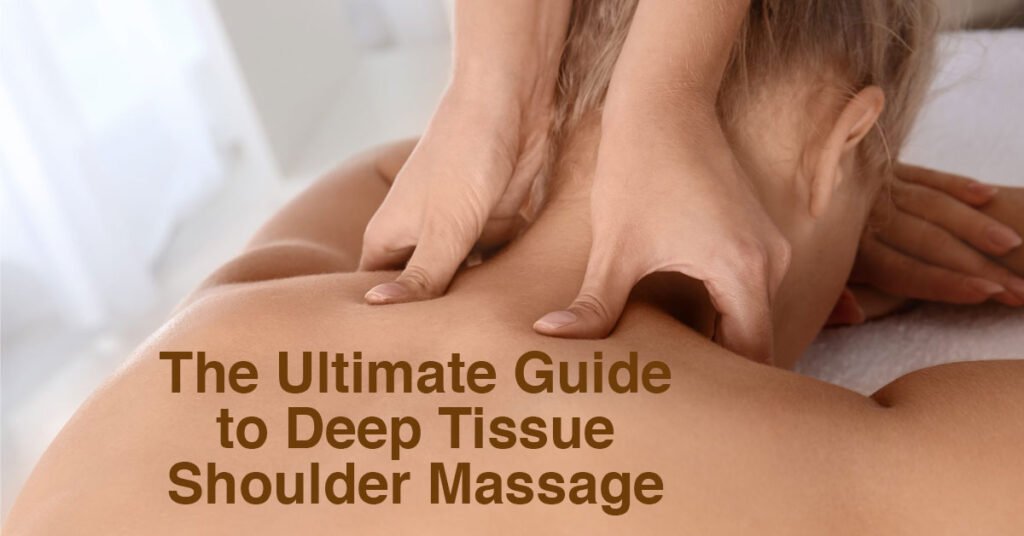Our shoulders can become sore and worn out after a long day of work because of stress and anxiety. A deep tissue shoulder massage can provide a more substantial and long-lasting cure than a light rubdown, which may only offer momentary relief. This comprehensive guide to deep tissue shoulder massage offers ideas, methods, and advice to help you unwind and revitalise whether you enjoy massages or are simply looking for relief from shoulder discomfort.
Knowledge of Deep Tissue Massage
Targeting the deeper levels of the muscles and connective tissues, deep tissue massage is a therapeutic therapy. Deep tissue massages dive into the knots and stress hiding beneath the surface, as opposed to Swedish or relaxation massages, which concentrate on softer strokes and surface-level relaxation. It works well to reduce pain, relax chronic muscle tension, and increase flexibility.
The Pain Relief Benefits of Deep Tissue Shoulder Massage: The capacity of deep tissue shoulder massage to reduce persistent discomfort, such as that brought on by muscular knots or tension headaches, is well documented.
Better Posture: Poor posture is frequently caused by shoulder tension. Deep tissue massage can help you stand higher and move more freely by releasing this tension.
Enhanced Range of Motion: Deep tissue massage’s therapeutic techniques can aid in enhancing joint flexibility and mobility, which facilitates daily motion.
Releasing endorphins, the body’s natural feel-good hormones, deep tissue massage promotes relaxation and lessens stress in addition to its physical benefits.
Injury Recovery: Deep tissue massage helps speed up the healing process for people who are recuperating from shoulder injuries by boosting blood flow and encouraging tissue regeneration.
Effective Deep Tissue Shoulder Massage Methods
Warm-Up: Start by lightly warming up your shoulders by massaging them with long, sweeping strokes. This aids in muscular relaxation and gets them ready for harder work.
Apply gentle pressure with your fingers or thumbs to the knots and tense areas. To make sure the pressure is bearable, move slowly and steadily while speaking to the recipient.
Apply circular motions with your fingertips to the tight areas to reduce friction. The blood flow is improved and adhesions are broken away with this approach.
Stripping: Apply pressure along the length of the muscular fibres with your knuckles or elbows. This method aids in relaxing the muscle and lengthening it.
Cross-Fiber Friction: Gently run your fingers perpendicularly across the muscle fibres. This method helps to break down scar tissue and correct muscular tissue.
Use mild stretching techniques to increase flexibility and release stress. Be careful not to extend too far or irritate anyone.
Successful Deep Tissue Shoulder Massage Techniques
Communicate with the individual getting the massage at all times. Inquire about their level of comfort, pain tolerance, and pressure preferences.
Encourage slow, deep breathing all throughout the massage. This encourages a more efficient release of stress while also assisting the recipient in relaxing.
Hydration: To assist flush out toxins released from the muscles after a deep tissue massage, it’s important to consume plenty of water.
Encourage gentle stretches and relaxation methods the recipient can practice at home to preserve the massage’s therapeutic effects.
Professional Assistance: If you’re unclear how to execute a deep tissue shoulder massage, think about consulting with a trained massage therapist. They are qualified and experienced to offer massages that are both secure and efficient.
Contraindications and Precautions
Although deep tissue shoulder massages can be quite helpful, not everyone may benefit from them. Knowing certain circumstances where deep tissue massage should be avoided or altered is crucial:
- Recent injuries or surgeries
- Open wounds or skin conditions
- Blood clotting disorders
- Osteoporosis
- Pregnant individuals (consult a healthcare provider)
- Severe chronic health conditions (consult a healthcare provider)
In Conclusion, The strength of a deep tissue shoulder massage rests in its capacity to penetrate the muscle’s deeper levels and offer relief that goes beyond the skin. You can provide yourself or others a revitalizing experience that encourages relaxation, pain alleviation, and increased wellbeing by being aware of the procedures, advantages, and precautions connected with this therapeutic practice. The definitive guide to deep tissue shoulder massage gives you the knowledge you need to start your journey towards wellness and comfort, whether you’re looking for relief from the strains of everyday life or want to improve your massage talents.

